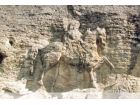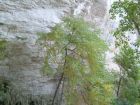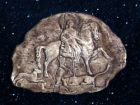UNESCO sites, Madara Horseman
Madara Horseman
It is in the north-east of Bulgaria, 20 km from the town of Shumen, near the village of Madara. This is the most significant monumental piece of artfrom the early Middle Ages, unique of its kind in European culturalhistory
The relief was cut in a vertical rock at 23 m height during the 8th century. It measures 2.6 m in height and is 3.1 wide at the base.
The relief comprises a life-size horseman, a lion, a dog, and Greek inscriptions.
The horseman is wearing a knee-length garment and is holding the reigns in his left hand. With the right hand, he has thrown a short spear with a flag at the lion lying at the horse’s front legs.
The high back of a saddle is visible behind the horseman.
The man’s right foot is thrust in a stirrup.
The dog is running behind the horse.
The image is believed to show the victorious khan Tervel. It carries resemblance to the scenes of triumph in the Iran’s east and the artistic traditions of antiquity.
The details of the relief make likely its Proto-Bulgarian origin.
The Proto-Bulgarian inscriptions, written in Greek, announce events in Bulgarian-Byzantine relations under the rule of the khans Tervel, Khormisosh, and Omurtag during the 8th and 9th centuries.
One of the inscriptions presents the forceful abdication and the exile of the Byzantine emperor Justinian in 705.
Having managed to escape, Justinian sought help from the Bulgarians.
Khan Tervel and his army helped him to recover the throne of Byzantium. In return, Tervel received honours and gifts, and recognition of the title of Caesar- Tsar, as well as land south of Hemus and an annual tax from Byzantium.
The Madara Horseman is a part of the national history and archaeology reserve of Madara.
It was once connected with the large worship complex of heathen temples, palaces and houses, and other premises, built by khan Omurtag on the Madara rock terrace.
At the rock base, there is also a large cave called the Nymphs’ Cave, where the Thracians worshiped their deities in ancient times.
Scientist have found many prehistoric cult figures and tablets dedicated to the three local nymphs, Zeus, Heracles, Dionysius, Cibbela, the Thracian horseman-hero Heros, etc.
The Madara horseman is the only rock relief in Europe dated back to the early Middle Ages.
The Madara Riderwas included in the World Cultural and Natural Heritage List at the World Cultural and Natural Heritage Committee session of 1979 in Luxor, Egypt







